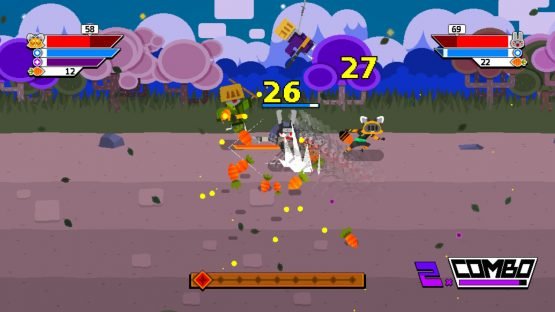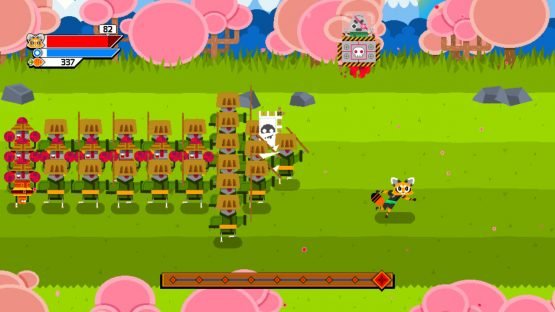Ninjin: Clash of Carrots Review (Switch)
I very much enjoy my absurd games with animal characters in them, having spent most of my childhood playing Sonic and such titles, and so when I saw Ninjin: Clash of Carrots from Pocket Trap on the EGX 2018 show floor, I absolutely had to play this seemingly nonsensical hack and slash adventure.
Starting with the narrative as always, the story of Ninjin is completely and wonderfully ridiculous. The quiet village of Usagi is invaded, and all of their entire crop of carrots for that season are stolen. So Ninjin, the ninja bunny, sets out on a mission with Akai, an equally ninja fox, to get back the carrots for the village and topple Shogun Moe and the other villains behind such a crime.
So, yeah, the story is a little unhinged, which is only increased by the cast. The main two characters are fairly innocuous, sure, but the supporting cast are all comically overblown and entirely absurd. This can especially be seen in the villains, who are resoundingly pantomime at best, complete with unnecessarily over-thought out plans to dispatch the heroes and bizarre dialogue and general characteristics.
The basic gameplay of the game is simple but massively entertaining. The player simply gets thrown into increasingly difficult waves of enemies in an infinite runner style set-up. The player has two options, attacking or dashing. The attack will essentially use whatever weapon you have equipped, and the dash is a temporarily invincible movement that can take you through enemies taking no damage.

These two manoeuvres can be combined to perform as dash attack that can be used to clear a lot of enemies at once or by its far more beneficial usage, attacking behind you. As a lot of waves will have enemies that close in from behind, mastering this little attack (executed by pressing the attack and dash at the same time along with holding back) is pretty much essential to progress.
Be careful, however, as the dash along with your standard attacks all require stamina. How much you have is displayed as a little blue bar beneath your health bar and this will greatly drop with each dash. Luckily it replenishes rather quickly, but effective management of this bar will aid the player in being able to escape from some pretty hairy situations.
Stamina notwithstanding, you can’t just slash your way blindly through the levels anyway, especially because the game will regularly throw new enemy types at you that will require a different approach to dispatch and the end of almost every level will bring with it a boss encounter too against either a more powerful version of a standard enemy or an entirely unique encounter.

Regardless of which one it is, these are powerful enemies that have a lot more health, and can reduce your health quickly. They can pose an interesting challenge, and a shake up to gameplay; in fact, the only real downside to them is if you’re playing in two-player mode, their threat is massively diminished as you can just pincer them and have both players simply hammer the attack button.
Another reason to focus on what you’re doing is that every enemy you take down will drop a large amount of carrots that you most definitely should pick up as they’re the currency in this game (more on this a little later). There are both normal carrots of various sizes and psychedelic rainbow carrots, which I’m pretty sure wouldn’t taste very pleasant. Sometimes the enemies will also drop chests containing an additional treasure, which I will also get into shortly.
For such a simple game in essence, it is quite incredible just how much there is to unlock in the game. There are a lot of weapons, projectile weapons, accessories and artefacts to alter and augment your chosen playstyle, most of which will dramatically alter aspects of how your chosen ninja will behave. In fact, there’s roughly 200 of them in total, which is a fair amount of things to unlock and a lot to experiment with.

The weapons range from daggers to spears by the way of the standard weapon type of swords, all of which feel remarkably different and can often look totally ridiculous (the giant futuristic sword with two fans in it is a highlight). The best part about these, much like all of the other items in the game, is that each one has a little silly explanation of it, some of which genuinely swayed me to using them.
The projectile weapons are fantastic, giving an additional means of attacking in any direction. Furthermore, there are certain types of enemies that are best taken down from a distance, like those that explode, for a small example. The different projectiles can have some interesting effects too, like the Bouncy Shuriken for instance, which will ricochet off a successful hit, gaining power each time it bounces.
Artefacts act as little character buffs and bonuses all the while they are equipped. Some give quite simple advantages like increasing your character’s health or stamina, which are useful but really shouldn’t be relied on too heavily. However, there are artefacts that add incredibly interesting modifiers to your loadout, such as the Cursed Skull, which gives the player the ability to regain health for every three enemies slain. So, I’d recommend experimenting with various loadouts as you unlock more things to find a comfortable playstyle.

You can obtain all of these items in two main ways. The first, and most fun, is by collecting the chests mentioned earlier. You have to make sure you make an actual effort to collect these as you don’t stop moving so they can be missed if an enemy drops one. If you succeed at collecting it, you have the beautiful moment at the end of the level where you can open the chest and gain your random treasure.
The other way, which is less fun but infinitely cuter, is buying them from Corgi at either the standard or ‘Shady’ shop. The standard shop, run by an absolutely adorable little dog, will sell you weapons, projectiles and artefacts in return for carrots. The ‘Shady’ shop, which is only open at night, will allow the player to buy accessories for their character in return for the rarer rainbow carrots. Both stores gain more products as you progress, and can be accessed at any point from the world map.
Aesthetically, Ninjin is somewhat of a mixed bag. The more simplistic visuals that are achieved because of the pixel artstyle result in a lot of the game feeling repetitive and stale. The levels rarely look visually distinct, even with changes of lighting not really distinguishing them apart. The enemies mostly look the same, making it slightly difficult in the more hectic levels to work out what method of dispatch to use.

This being said, the character designs in the game are absolutely adorable with each one brimming with personality. The bosses are also wonderfully realised both in their design and gameplay. The weapons and items are all interesting, with little quirks too each one, even the most basic. Finally, all of the menus and UI are both clear and colourful, with the world map itself being a particular highlight.
Musically this title is lacklustre, with the music having the same dull monotony that the visuals often fall into. In fact, the only truly standout track from the game is the shop music, which changes between the standard and ‘Shady’ iterations. The end result is that the game from an aesthetic standpoint just comes across as quite repetitive and half baked.
As a game, I would actually recommend giving Ninjin: Clash of Carrots a look; the gameplay hook is interesting, the amount to unlock is staggering, and the moment-to-moment is simple. However, the gameplay itself does become somewhat repetitive as the player progresses, an aspect that is sadly reinforced through the also repetitive visuals and sound. The drop-in two-player is wonderful, and definitely makes the game more enjoyable too. It has so much potential to be fantastic and does have a lot of charm and things to love about it; but, to paraphrase the game itself, for carrot’s sake there’s just not enough to it.

Ninjin: Clash of Carrots is out now on PS4, XBox One, Nintendo Switch and Steam. Do you think Ninjin and his ninja skills have done enough to sell you on his adventure? Let us know in the comments, or on Twitter, and check back for more coverage of titles like this and Japanese games too.
- New Persona 5 Royal Trailer Introduces Kasumi And Special Edition Revealed - June 6, 2019
- New Bloodstained: Ritual of the Night Character Revealed Ahead Of Release - May 31, 2019
- Final Fantasy XIV: Shadowbringers Preview - May 29, 2019





